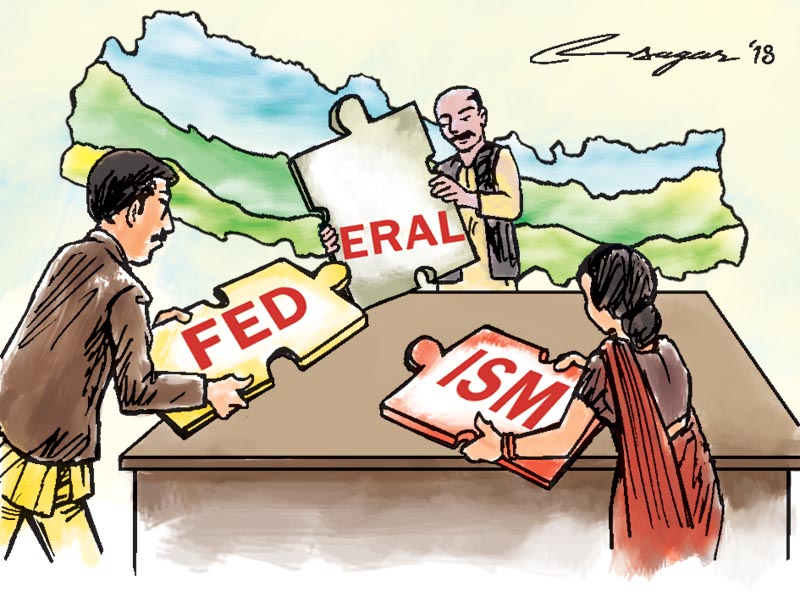Constitutional disputes: Ways to meet challenges
As the country moves to operationalise federalism, disputes among federal, provincial and local level structures cannot be ruled out. There is an urgent need to clear confusion regarding the newly adopted federal system of governance
potential disputes among federal, provincial and local level structures cannot be ruled out as the country moves to operationalise federalism. Even in the best of scenarios, such tussles are highly likely. So when there are enough legal, political, economic and social confusion regarding the newly adopted federal system of governance, such disputes are inevitable. Hence it will be wise to foresee the possibilities of such disputes and prepare for healthy and systematic resolution. After all the success of the new constitution—and federalism—hinges on smooth functioning of three tiers of government.
In our federal system, there are seven provincial and 753 local governments. The constitution provides for specific list of rights for all the levels of government. The constitution has Schedules to deal with a number of issues. Schedule 5 provides the list of 35 areas falling under federal jurisdiction.
Schedule 6 provides the list of 21 areas falling under the provincial jurisdiction. Schedule 7 provides the list of 25 areas falling under the concurrent jurisdiction between federal and provincial levels. Schedule 8 provides the list of 22 areas falling under the local level jurisdiction.
Similarly, Schedule 9 provides the list of 15 areas falling under the concurrent jurisdiction among federal, provincial and local governments. However, there is every possibility of disputes arising among the three tiers of government over the exercise of their jurisdiction in coming days.
The constitution has two specific provisions to deal with such disputes. Part 20 has proposed a number of provisions on inter-relations among federal, provincial and local governments. This part talks about inter-relations between: federal and provincial governments, provincial and local governments, federal and local governments, and federal, province and local governments. It has also laid down procedures for coordination and cooperation. It has also provided for an institutional setup in the form of Inter-Provincial Council (IPC) headed by the prime minister.
The second aspect in the constitution is the curative one. If disputes arise, they will have to be dealt with through a set procedure. There is a constitutional bench of the Supreme Court (SC). This five-member bench is headed by the chief justice (CJ), with four SC justices as members. This bench looks into the disputes once or twice a week.
Article 137 (2) specifies two broad categories of disputes that can be examined by the bench. One, disputes on jurisdiction arising between Centre and province, or province and province, or province and local level, or between local levels. Two, disputes on the election or eligibility of members of federal or provincial parliament. Furthermore, Article 137 (3) states the CJ can refer any dispute to the bench if he/she thinks the issue calls for serious constitutional interpretation.
Likewise, Article 235 (1) of states that the federal parliament shall make necessary laws to maintain coordination among the federal, provincial and local governments. The Office of the Prime Minister and Council of Ministers and the Ministry of Law, Justice and Parliamentary Affairs have already started drafting the law. However, there is little consultation on the draft bill among different levels of government and stakeholders.
Similarly, Article 235 (3) states that the processes and procedures for the settlement of disputes among and between provinces and local governments shall be as provided for in the provincial law.
The IPC is a key agency to facilitate smooth relations among three tiers of government and promote coordination. However, there is a lack of rule to govern its meeting.
In fact, some provincial leaders have openly expressed their dissatisfaction over the lack of initiative by the federal government in activating the IPC.
Even at this early stage when the three tiers of government are just beginning to function, there are over 400 cases filed at the constitutional bench. It indicates that the bench could be over-burdened soon. Another challenge is the tendency to push every kind of case to the bench. Moreover, almost all the 400 cases before the bench are the ones that were referred to it as per Article 137 (3).
Some immediate steps hence are a must.
First and foremost, the federal government must win the confidence of chief ministers and provincial leaders and convince them that they are committed to implementation of federalism.
Activation of the IPC through enactment of law is a must. There has to be periodic, preferably monthly, meeting of the council where the chief ministers and federal ministers can freely discuss their problems, disputes and ways of resolutions. There is also a need to fine-tune the operation of constitutional bench. First it needs an act in line with the spirit of the constitution.
The constitutional bench also lacks a separate secretariat to facilitate its operation. The bench needs to give priority to cases under Article 137 (2) rather than under Article 137 (3).
These shortcomings have affected the overall operation of the constitution itself. The afore-mentioned issues must be addressed sooner than later to ensure proper functioning of federal system.
Pradhan is executive director of Nepal Law Society






